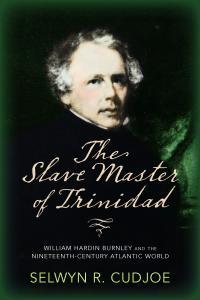The Passing of the Pointer Man
By Dr Selwyn R. Cudjoe
August 23, 2021
PART 2
EL TUCUCHE can be made the symbol of our greatest achievements—it is graced with the sovereignty that represents our transcendent power over Douendom where we are still held in disarray and ignorance. Above all, is Aripo, symbolically, the Eye am that Eye am, the one God in whose house there are many mansions, and to which many are the paths!
—LeRoy Clarke, Parables of Our Joyless Days
In the 1950s a modern phase of T&T's artistic development revealed itself in the paintings of M. P. Alladin, Geoffrey and Boscoe Holder, Leo Basso, Alfred Codallo, and Carlisle Chang. In "Painting in Trinidad and Tobago," Pat Bishop declared: "These painters were not merely taking the brave step of painting in black face but were also prepared to participate in the modification or destruction of traditional image making."
This movement showed further development in the 1960s in the works of Sybil Atteck, Ralph and Vera Barney, Pat Bishop, Isaiah Boodoo, Wili Chen, Pat Chu Foon, and Marguerite Wike who gathered around Carlisle Chang's Carlart Studio in Port of Spain. They all sought to capture a new way to see and interpret our world. One of the most elaborate efforts of that period was Chang's Independence mural, "The inherent Nobility of Man," which was installed at the Arrival Building of Piarco Airport.
Just as Cazabon and Clarke were inspired by the world's best painters, Chang was influenced by the works of Diego Rivera and the other Latin American muralists that is reflected in "The Inherent Nobility of Man." The central motif of that work was "a winged Amerindian" or what Trinbagonians called "The Humming Bird Man" that flew over the country to pollinate a new national consciousness. When this mural was destroyed in the early 2000s, Glenn Roopchand, a protégé of Chang's, was commissioned to recreate it in 2006.
Roopchand was 16 when he met Clarke at Chang's studio. He says: "LeRoy had the mind of a mystic. He possessed a self-imposed independence and inner strength which he displayed throughout his career. He was involved with drama so he could play the role. The first time I saw him, he looked like a quiet volcano that could erupt at any time. As he developed his confidence, he became a very self-conscious artist.
"I saw LeRoy's power at St. Mary's College where he staged an exhibition, 'Fragments of a Spiritual.' It was of great significance to me and the country. It was the first time I saw his artistic effulgence in full bloom. He represented an artist who had come out of his shell, declared his identity and intimated what we could expect in the future. This exhibition inspired dignity and pride in the masses and showed an important aspect of our Caribbean identity."
Clarke's power was on display again in 2015 in his exhibition, "Eye Hayti…Cries…Everywhere," where he set out "to capture, not only literary images of the result of Storm or Hurricane or Earthquake, but to charge those images with tensions that can arouse in the viewer, aural, as well as visual and optic sensations—with a range of continental emotional turbulence, Hayti Cries…."
Clarke was successful in that endeavor. He was also prescient in light of the troubles that beset Haiti today. A prominent aspect of Clarke's psyche was on full display in "Eye Hayti…Cries…Everywhere." Haiti, it seemed, presented him with an avenue to display a challenge that haunted his mind: "the redemption of my race." This sentiment was inscribed in every line, phrase and utterance in his drawings, his paintings and his verses. Here, Clarke was fighting with and for a language to express the innermost depths of his being.
Clarke's artistic perspective connects deeply with those of his contemporaries. Wilfredo Lam said that in "The Jungle" and his other works he "tried to relocate Black cultural objects in terms of their own landscape and in relation to his own world." Clarke, in turn, uttered the cypher: "The striking signature of Romare Bearden's primal memory marks the vast horizon of his life's oeuvre."
Perhaps Roopchand said it best: "LeRoy's presence on the art scene was like a tsunami sweeping through a young society yearning to be motivated out of its slumber that only the creative mind could stimulate. He reminded me of Papa Bois, stomping through the forest of our imagination recharging the ruins that was caused by our oppressors."
Vladimir Nabokov, a professor at Cornell University and Wellesley College, reminded us that "when dealing with a work of art we must always bear in mind that art is a divine game. These two elements—the elements of the divine and that of the game—are equally important. It is divine because this is the element in which man comes nearest to God through becoming a true creator in his own right. And it is a game because it remains art only as long as we are allowed to remember that, after all, it is all make-believe" ("Nabokov on Dostoyevsky," New York Times, August 21, 1981). Clarke was trying to touch the divine through his work.
In 1977 Lam exhibited his lithographs at the National Museum of Fine Arts of Havana. After studying Cuban painting and seeing the work of many young artists, Lam declared: "For me Cuban painting is missing something. In each work, I see all the letters, but not the sentence."
Fate placed upon Clarke's shoulders the burden of completing the sentence that inhered in the modern phase of T&T's artistic development. It is a responsibility he handled with grace as he searched to achieve the El Tucuchian ideal. Through his art he sought to convey that message to all of us.
Prof. Cudjoe's email address is scudjoe@wellesly.edu. He can be reached @ProfessorCudjoe.
Share your views here...

The Slave Master of Trinidad by Dr. Selwyn R. Cudjoe
|

